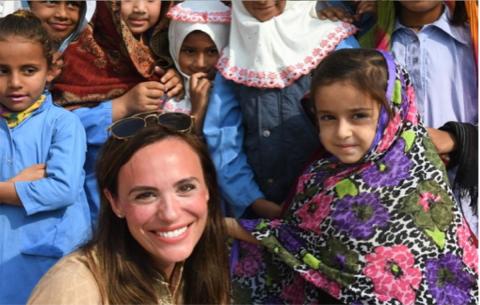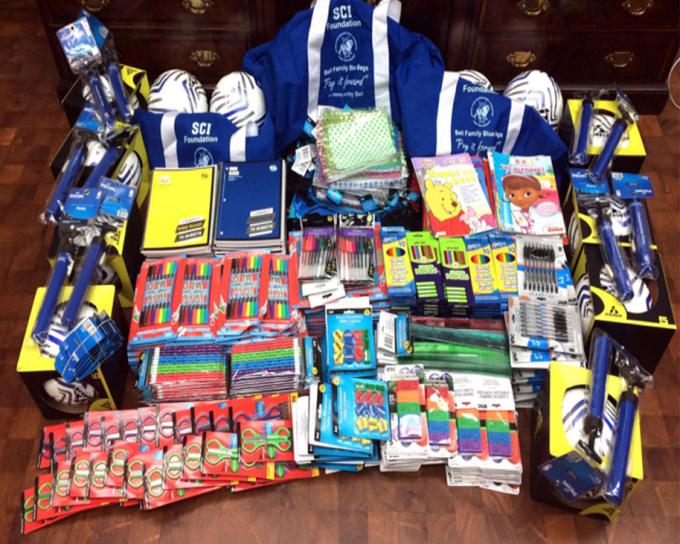Feelings of compassion, humanity and a sense of personal appreciation unfold within us when we give back to others. There is nothing more significant than an opportunity to center one's focus on how much we have to be grateful for. This comes from the act of giving to people who are less fortunate than us.
Safari Club International Foundation (SCIF) is recognized for its leading role in the conservation of wildlife, outdoor education and humanitarian services. One of the most visible programs and the easiest to participate in is the “Blue Bag” program. The program's premise is for traveling sportspeople to fill a sizeable blue duffel bag and then deliver it to needy people whose resources do not come easily in remote parts of the world, where we hunt. Contents often include health and hygiene supplies, educational materials and/or recreational supplies.
In the past 18 months, my husband Ricardo and I have delivered seven Blue Bags around the world. We opt for high-quality, elementary school age educational workbooks, writing tools, rulers, duct tape, blank notebooks, and divide them into thirty backpacks, along with some deflated soccer balls, with hand pumps.
Our cost for the materials in each Blue Bag is approximately $800. Some local Safari Club International (SCI) chapters offer pre-filled bags or even funds to help offset the personal expense, so please check with your local chapter and see if they provide any supplemental support. We have delivered Blue Bags to schools in Mexico, twice to Pakistan, Benin, South Africa, Namibia and Zambia.
Most of the time, waived excess baggage fees are easily attainable, but you must contact your airline about a month in advance of travel, with each airline having varying policies. The airline will need to attach a note to your reservation, stating the fees will not be collected at the time of departure due to the humanitarian and not-for-resale contents of the bag. When traveling with a Blue Bag, I always include a printed inventory of the contents, intended destination and a letter from SCIF describing the Blue Bag program and its contents.
Our typical Blue Bag contents are as follow:
Lightweight drawstring backpacks (x30) each containing the following, plus 4 soccer balls and pumps:
- 1 PVC Polka-Dot Binder Pouches with Zipper Closures
- 4 Inc. Pencil Erasers
- 4 #2 Wooden Pencils
- 10 Liqui-Mark Colored Pencils
- 8 Double-sided fine line/broad line wash markers or 6 Jot Assorted Novelty Markers
- 1 Sesame Street or Disney themed Workbook
- 1 Jot 12-in. Translucent Plastic Ruler
- 1 Children blunt and pointed scissors, 5 inch
- 2 Inc. Clipclick Black Ballpoint Pens
- 1 Soft Grip Gel Color Pen
- 4 Fun Shapes Pencil Sharpeners
- 1 70-sheet wide-ruled spiral single-subject notebook or 1 Jot 2-Subject Colored Spiral Notebook
- 1 Packaging Tape, 45-yd.
On our most recent trip to Paksitan, Ricardo and I went back to the Dureji Girls' School in the Balochistan area, about two hours north of Karachi. This was our second time delivering a Blue Bag to this school. Pakistan is known for having fewer opportunities available to girls, so it was vital for us to choose a girls' school.
On our first visit twelve months before, the girls were timid, with quiet nervous giggles, and standoffish. Being foreigners, and in the presence of men from the hunting company, was an uncomfortable cultural stretch for them. Regardless, it encouraged a dialogue between the girls and us, in ways that we all would not ordinarily have experienced before. When people choose to give, we unite from different sectors and nations in the name of a common cause – in this case, hunting.
Our second visit this year had a completely different vibe. The girls recognized us and were eager to see our recent hunting photos and have the stories of climbing their mountains translated to them by their teachers. It was very important to us to have the opportunity to say thank you to the girls for allowing us into their village and to explore their mountains. We all want to feel that we contribute, add value and have meaning and purpose in our lives. As a hunter, I always think it is my responsibility to be publicly appreciative of the incredible experience, not just the harvest, in the places and with the people we visit during our hunting travels.
Sadly, our hunting community is shrinking worldwide, and the number of anti-hunters is growing in both organizational sophistication and public funding. It is up to us as individuals to be ambassadors of the international hunting community, and our often-misunderstood lifestyle.
When we leave a Blue Bag, as hunters, we also leave a positive impression. We show in a meaningful way a tangible contribution to the young people’s education. These young, future leaders are left with a clear example of how hunting and hunters benefit the places they visit, beyond just the distributed game meat or hunting income.
Giving back to society has profound benefits for both the giver and the recipient. We encourage all SCI members to participate in this rewarding program and share the real and positive image that hunters care not just about the wildlife, but also about local people. Here is to hoping that you are inspired to give and contribute to the rural and remote communities that we find ourselves traveling through while on your next hunt.
For more information, go to http://safariclubfoundation.org/bell-family-blue-bag-program/ or contact Karen Crehan at [email protected].–Britt Longoria



